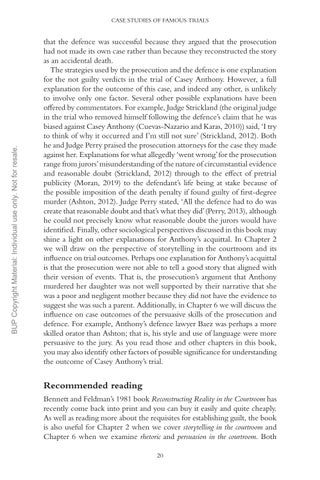BUP Copyright Material: Individual use only. Not for resale.
CASE STUDIES OF FAMOUS TRIALS
that the defence was successful because they argued that the prosecution had not made its own case rather than because they reconstructed the story as an accidental death. The strategies used by the prosecution and the defence is one explanation for the not guilty verdicts in the trial of Casey Anthony. However, a full explanation for the outcome of this case, and indeed any other, is unlikely to involve only one factor. Several other possible explanations have been offered by commentators. For example, Judge Strickland (the original judge in the trial who removed himself following the defence’s claim that he was biased against Casey Anthony (Cuevas-Nazario and Karas, 2010)) said, ‘I try to think of why it occurred and I’m still not sure’ (Strickland, 2012). Both he and Judge Perry praised the prosecution attorneys for the case they made against her. Explanations for what allegedly ‘went wrong’ for the prosecution range from jurors’ misunderstanding of the nature of circumstantial evidence and reasonable doubt (Strickland, 2012) through to the effect of pretrial publicity (Moran, 2019) to the defendant’s life being at stake because of the possible imposition of the death penalty if found guilty of first-degree murder (Ashton, 2012). Judge Perry stated, ‘All the defence had to do was create that reasonable doubt and that’s what they did’ (Perry, 2013), although he could not precisely know what reasonable doubt the jurors would have identified. Finally, other sociological perspectives discussed in this book may shine a light on other explanations for Anthony’s acquittal. In Chapter 2 we will draw on the perspective of storytelling in the courtroom and its influence on trial outcomes. Perhaps one explanation for Anthony’s acquittal is that the prosecution were not able to tell a good story that aligned with their version of events. That is, the prosecution’s argument that Anthony murdered her daughter was not well supported by their narrative that she was a poor and negligent mother because they did not have the evidence to suggest she was such a parent. Additionally, in Chapter 6 we will discuss the influence on case outcomes of the persuasive skills of the prosecution and defence. For example, Anthony’s defence lawyer Baez was perhaps a more skilled orator than Ashton; that is, his style and use of language were more persuasive to the jury. As you read those and other chapters in this book, you may also identify other factors of possible significance for understanding the outcome of Casey Anthony’s trial.
Recommended reading Bennett and Feldman’s 1981 book Reconstructing Reality in the Courtroom has recently come back into print and you can buy it easily and quite cheaply. As well as reading more about the requisites for establishing guilt, the book is also useful for Chapter 2 when we cover storytelling in the courtroom and Chapter 6 when we examine rhetoric and persuasion in the courtroom. Both 20

